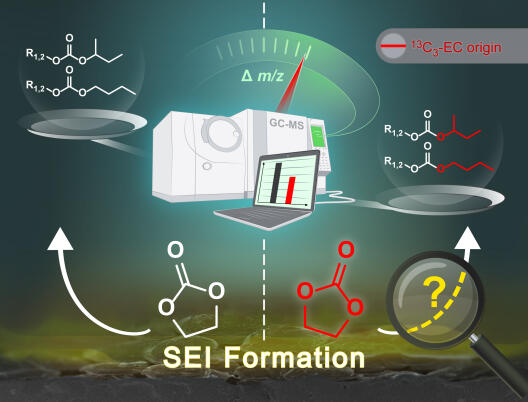Detailed Understanding of Electrolyte Decomposition during SEI Formation
Despite its central influence on the performance, lifespan and safety of the lithium-ion battery, knowledge about the Solid Electrolyte Interphase (SEI) formation is still limited. The interphase that forms between the liquid electrolyte and the solid electrode during the first cycles of the battery is extremely thin and unstable against various surface sensitive methods. A team of MEET Battery Research Center led by scientist Christoph Peschel has therefore focused its analysis on the electrolyte and its decomposition products. Both have a decisive influence on the characteristics of the SEI and enable conclusions about reactions during its formation.
Origin of carbon atoms identified

In the period of cell formation, numerous complex electrochemical reactions occur in the battery cell. Some of them are essential for the formation of the SEI. Others result in the further, undesirable decomposition of the electrolyte. “In order to manipulate these processes, we want to decode the reactions to optimise the SEI formation using additives or even synthesise it artificially and thus tailor-made," explains MEET researcher Christoph Peschel. In this study, the team paid particular attention to the analysis of aged products in the electrolyte.
The scientists labeled an electrolyte component isotopically. Using mass spectrometry and fragmentation experiments, they then examined its reaction pathways during the formation of the interphase. "We were able to successfully identify the origin of the carbon atoms that occurred in the aging product," says Peschel. In order to extract and detect low concentrated, volatile organic species in particular, the researchers also combined gas chromatography with preconcentration via solid phase microextraction.
Study published as Cover Page
The MEET scientists Christoph Peschel, Fabian Horsthemke, Marco Leißing, Dr. Simon Wiemers-Meyer, Jonas Henschel, Prof. Dr. Martin Winter and Dr. Sascha Nowak have published the more precise results on aging mechanisms in the lithium-ion battery as a Cover Page in the specialist journal "Batteries & Supercaps". The article in English language is open access.
With their study, the scientists continue the intensive research of the electrolyte at MEET Battery Research Center. With the results of previous analyses, the scientists have already gained a better understanding of its decomposition.

